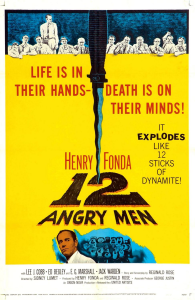The Narratives That Give Life
Rule of Law in Twelve Angry Men
By Gökçe Köksal and Yağızalp Güney

Twelve Angry Men, written in 1954 by Reginald Jones, is a play about a group of jurors, deciding on a boy’s life or death. The story implies the significance of a fair justice system within any given community. The play starts in a courtroom and a trial takes place in which all the evidence points towards the boy murdering his father. The jurors must decide whether the boy is guilty or not. The main idea of the narrative is about exposing the prejudices individuals have against the justice system, so it pits the idea of a fair justice system against a justice system which is individualizes biased sense of vengeance. Jurors must put away their prejudices about the boy’s ethnicity, background, age, and identity. These aspects all point to the legal necessity to be unbiased towards an individual. It is the boy’s right to be defended and he should be equal before the law like every individual in society. Juror 8, who respects human life the most, shows the value of human life to the other jurors in the room throughout the story and he as a character represents an ideal system, valuing human life when faced with reasonable doubt. He shows his reasonable doubt, and he succeeds in persuading the others by creating scenarios that could represent reality. His reasonable doubt shows that the boy is more likely innocent than guilty. Juror 8 is the protagonist in the story because he is the embodiment of a fair justice system that leans towards the value of human life in moments of uncertainty. On the other hand, Juror 3 shows the audience how misleading prejudices can be. He makes the case personal as he has problems with his own son. He lashes out at everyone, but he slowly realizes his mistake. He is the last juror to change his vote to not guilty. After he breaks down emotionally, he acts rationally and recognizes the value of an individual’s right to live and can separate his resentful past with his son from the boy’s case. When it comes to acting rationally, Juror 4 is an important figure in the play. He opposes juror 8 with facts instead of pure prejudice. He represents cold blooded rationality. He states facts related to the murder: the murder weapon’s unique look, the boy’s lack of memory in the cinema and he brings the eyewitness’s testimony where she saw the killing. When juror 8 proves rationally that information from the eyewitness could be questioned, he hesitates for the first time. He changes his vote to not guilty after having reasonable doubt. Juror 8 once shows the audience that a fair justice system must not only act on evidence, but it should also consider the possible different scenarios that result in the same outcome as well. When they search for clear evidence, they all slowly realize that the boy might be innocent. They might never know if the boy is guilty or not guilty, but they cannot punish an individual with death penalty unless they prove that one is fully guilty by evidence. Everybody is equal in front of the law but if there is a concept that surpasses the absolute rule of law: human life is what the law should strive to preserve.

